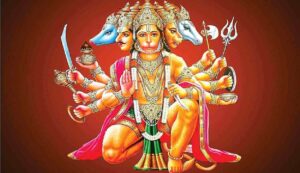How and why did Hanuman Ji assume the Panchmukhi form?
Panchmukhi Hanuman: The Panchmukhi form of Hanuman is a representation of his dedication and special abilities. In legend, adopting this shape demonstrates his incredible bravery and resolve. Ahiravana’s capture of Rama and Lakshmana during the invasion of Lanka is linked to this story in the Ramayana. Tell us just how and why Hanuman ji took on this shape.

The Conspiracy of Ahiravana
Ahiravana, the illusionist Tantric and king of Patala Loka, was Ravana’s brother (or son, depending on one’s perspective). He intended to use deceit to catch Rama and Lakshmana. He sent Rama and Lakshmana to Patala Loka, where he intended to sacrifice them, using his illusionary abilities. In order to prevent Ravana from losing the Lanka war, Ahiravana set out to assist Ravana and destroy Rama-Laxmana.
The visit of Hanuman ji to Patal Lok
Hanuman ji departed for Patal Lok to defend Ram and Lakshman as soon as he learned that they were being kept hostage. Hanuman ji discovered the path to Patal Lok and arrived there using his great abilities and bravery.
Acquaintance with Makardhwaj
Hanuman ji met Makardhwaj, a warrior, at the entrance of Patal Lok. Hanuman ji could not enter Patal Lok since Makardhwaj was the gatekeeper. The two fought each other fiercely.
The founding story of Makardhwaj
Makardhwaj claimed to be Hanuman Ji’s son. Hearing this, Hanuman ji was taken aback. He said that a drop of Hanuman Ji’s perspiration dropped into the water as he sprang into it during Lanka Dahan. The fish reared Makardhwaj (Capricorn), who was born from that drop. He was later named Ahiravan’s gatekeeper.
The love and direction of Hanuman ji
Knowing the truth, Hanuman Ji gave Makardhwaj a hug and explained who he was. Because of his devotion, Makardhwaj revealed Hanuman the path to Ahiravan.
The Five Diyas: Their Secret
Ahiravan’s life power is found in five distinct diyas (lamps), as Hanuman discovered. These diyas were positioned in each of Patal Lok’s five directions, and it was vital to extinguish them all at once in order to slay Ahiravan.
Taking on the Panchmukhi Shape
Hanuman assumed the Panchmukhi form in order to complete this challenging mission. Panchmukhi Hanuman had five faces in this very unusual form:
- East Face (Hanuman): This face represents his initial bravery and power.
- The South Face (Narasimha) is a representation of both protecting force and the annihilation of evil.
- The earth and creation are represented by the North Face (Varaha).
- West Face (Garuda): This face represents catastrophe and the devastation of poison.
- The upper face, or Hayagriva, is a representation of wisdom and understanding.
- Hanuman Ji murdered Ahiravan by using these five faces to simultaneously extinguish all five lights.
The emancipation of Lakshman and Ram
Ahiravan was slain by Panchmukhi Hanuman Ji, demonstrating his bravery and knowledge. He then transported Ram and Lakshman back to Lanka safely after releasing them from jail.
Panchmukhi Hanuman Ji’s Glory
The Panchmukhi form of Hanuman Ji is a representation of his unmatched bravery, power, and devotion. He demonstrated in this way that with strength and resolve, even the most difficult undertakings can be completed.
The significance of Panchmukhi Hanuman devotion
Worshiping Panchmukhi Hanuman Ji bestows unique fortitude, bravery, and self-assurance.
This shape offers protection against harmful energy and a variety of problems.
Devotees of Panchmukhi Hanuman enjoy prosperity and tranquility in life.

